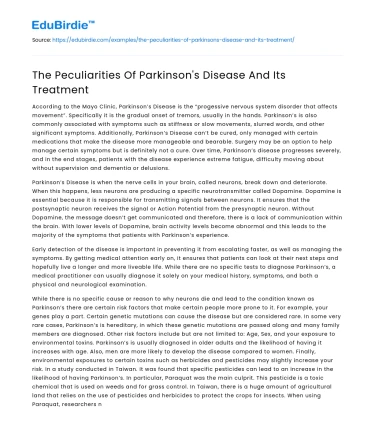According to the Mayo Clinic, Parkinson’s Disease is the “progessive nervous system disorder that affects movement”. Specifically it is the gradual onset of tremors, usually in the hands. Parkinson’s is also commonly associated with symptoms such as stiffness or slow movements, slurred words, and other significant symptoms. Additionally, Parkinson’s Disease can’t be cured, only managed with certain medications that make the disease more manageable and bearable. Surgery may be an option to help manage certain symptoms but is definitely not a cure. Over time, Parkinson’s disease progresses severely, and in the end stages, patients with the disease experience extreme fatigue, difficulty moving about without supervision and dementia or delusions.
Parkinson’s Disease is when the nerve cells in your brain, called neurons, break down and deteriorate. When this happens, less neurons are producing a specific neurotransmitter called Dopamine. Dopamine is essential because it is responsible for transmitting signals between neurons. It ensures that the postsynaptic neuron receives the signal or Action Potential from the presynaptic neuron. Without Dopamine, the message doesn’t get communicated and therefore, there is a lack of communication within the brain. With lower levels of Dopamine, brain activity levels become abnormal and this leads to the majority of the symptoms that patients with Parkinson’s experience.
Save your time!
We can take care of your essay
- Proper editing and formatting
- Free revision, title page, and bibliography
- Flexible prices and money-back guarantee
Early detection of the disease is important in preventing it from escalating faster, as well as managing the symptoms. By getting medical attention early on, it ensures that patients can look at their next steps and hopefully live a longer and more liveable life. While there are no specific tests to diagnose Parkinson’s, a medical practitioner can usually diagnose it solely on your medical history, symptoms, and both a physical and neurological examination.
While there is no specific cause or reason to why neurons die and lead to the condition known as Parkinson’s there are certain risk factors that make certain people more prone to it. For example, your genes play a part. Certain genetic mutations can cause the disease but are considered rare. In some very rare cases, Parkinson’s is hereditary, in which these genetic mutations are passed along and many family members are diagnosed. Other risk factors include but are not limited to: Age, Sex, and your exposure to environmental toxins. Parkinson’s is usually diagnosed in older adults and the likelihood of having it increases with age. Also, men are more likely to develop the disease compared to women. Finally, environmental exposures to certain toxins such as herbicides and pesticides may slightly increase your risk. In a study conducted in Taiwan. It was found that specific pesticides can lead to an increase in the likelihood of having Parkinson’s. In particular, Paraquat was the main culprit. This pesticide is a toxic chemical that is used on weeds and for grass control. In Taiwan, there is a huge amount of agricultural land that relies on the use of pesticides and herbicides to protect the crops for insects. When using Paraquat, researchers noticed that pesticide exposure is significantly associated with the prevalence of Parkinson’s Disease in that area (Yi-Hsien Cheng, Wei-Chun, C., Ying-Fei, Y., Chi-Wei, H., How, C. M., Chen, S., . . . Chung-Min, L. ). Therefore, while it is rare, Parkinson’s can be linked with exposure to certain toxins, like Paraquat.
Parkinson’s disease is treatable, but not curable. This means that once diagnosed, you can combat some symptoms with medications, surgery, and other methods, but there is no way to completely eradicate it. Therefore, early detection is key in maintaining symptoms and ensuring that the patient has the best quality life possible. In an experiment that was aimed at seeing the effects of stem cell transplantation and if it could treat the cognitive deficits of Parkinson’s, the main researchers concluded that there is some therapeutic help in patients who undergo stem cell transplantation and by “boosting the release of neurotrophic factors, enhancing the synaptic density and plasticity, and improving the survival of endangered neurons and replacing those already lost…” stem cells hold potential curative properties (Berrío Sánchez, J. P., Cucarián Hurtado, J. D., & de Oliveira, A. A.). While there is more research necessary, there is some evidence that suggests that stem cells are able to treat or even cure symptoms in Parkinson’s patients. Additionally, getting treatment is necessary because other factors may lead to a worse quality of life. In a study that analyzed the effect of depression, apathy, and motor symptms on Parkinson’s patients, it was concluded that severe depression caused a severe decline in the quality of life, followed by motor symptions and then apathy (Jones, J. D., Marsiske, M., Okun, M. S., & Bowers, D.).
While nothing will entirely eliminate the risk of Parkinson’s, there are a few preventative measures that are assumed may help decrease the likelihood. Some researchers claim that regular exercise is a good preventative measure, and others believe that those who consume caffeine regularly, such as green tea or coffee, are less likely to have Parkinson’s. Since the cause of Parkinson’s is largely unknown currently, it is hard to come up with preventative measures.
Works Cited
- Yi-Hsien Cheng, Wei-Chun, C., Ying-Fei, Y., Chi-Wei, H., How, C. M., Chen, S., . . . Chung-Min, L. (2018). PBPK/PD assessment for Parkinson’s disease risk posed by airborne pesticide paraquat exposure. Environmental Science and Pollution Research International, 25(6), 5359-5368. doi:http://dx.doi.org.proxy.cc.uic.edu/10.1007/s11356-017-0875-4
- Berrío Sánchez, J. P., Cucarián Hurtado, J. D., & de Oliveira, A. A. (2017). Stem cells transplantation for the treatment of cognitive deficits in Parkinson’s disease. Psychology & Neuroscience, 10(3), 307-313. doi:http://dx.doi.org.proxy.cc.uic.edu/10.1037/pne0000099
- Jones, J. D., Marsiske, M., Okun, M. S., & Bowers, D. (2015). Latent growth-curve analysis reveals that worsening Parkinson’s disease quality of life is driven by depression. Neuropsychology, 29(4), 603-609. doi:http://dx.doi.org.proxy.cc.uic.edu/10.1037/neu0000158






 Stuck on your essay?
Stuck on your essay?

